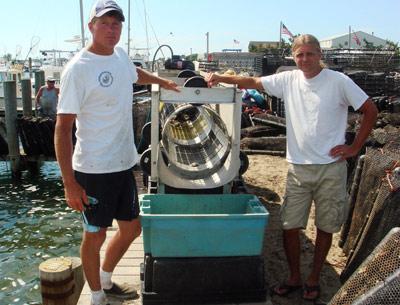Oyster Vineyard Grows ‘Pearls’ On the Surface

If you order a dozen oysters anywhere between Montauk and New York City these days, there’s a good chance they will be Montauk Pearls, grown in Lake Montauk. The Montauk Shellfish Company’s mariculture farm, located on the east side of the lake, is thriving. Its “surface-grown and ocean-finished,” method is the first of its kind in New York State.
Sharing the helm are a fisherman and a biologist, a perfect combination according to the “two Mikes,” as they call themselves, Mike Martinsen and Mike Doall. The oyster-growing pioneers have gone from seed idea to an inventory in the hundreds of thousands in just three years, though not without a lot of work, and, in Mr. Martinsen’s case, a few detours.
“The surface growout is key,” said Mr. Doall. “The oysters are tumbled by wave action, which makes a harder shell, and a better shape. Sunlight helps control bio-fouling. We flip the bags once a week. And there’s more phytoplankton, their food, on the surface.”
After the oysters grow to about two inches from hinge to bill they are taken offshore into Block Island Sound for “ocean finishing.” Mr. Doall called Block Island Sound the cleanest water in the state, “and saltier than the lake. It impacts the taste, giving it a clean, fresh, salty finish.”
From seed to just under three inches, a cocktail-size oyster with a salty finish takes about a year and a half.
Mr. Martinsen took a few detours on his way to mariculture. “I always clammed,” he said, standing in front of the company’s tumbler, a stainless steel cylinder that breaks oysters apart, removing stones and any vegetation as it turns. “Started at 11 years old. My first boat was a 16-foot sharpie.”
Harvesting and selling shellfish was common practice for kids in the Northport neighborhood where he grew up, and when the old Long Island Oyster Farms went out of business in the late 1980s it created a submarine gold mine for them. “We were harvesting from the wild, then we went onto the oyster farm property. They left behind a small fortune in oysters. Probably 40 baymen worked it. I was making $1,200 a day.”
The windfall ended in 1997, when the shellfish disease known as MSX wiped out the oysters. “It was the year I got married, and I was on my ass,” Mr. Martinsen said.
Things changed for the better when someone offered to put him into business distributing lobsters. “I was buying from 16 boats, thriving with a tractor-trailer. Then, [the lobsters] died off.” The blight was blamed on sprayed insecticide meant to kill mosquitoes.
The second letdown led him to Stony Brook University, where he earned a bachelor’s degree in biology that at first got him nowhere, he said. He did meet Mr. Doall, however, who had earned his master’s degree there and was researching ways to restore depressed shellfish populations.
The two Mikes started talking about oyster farming in 2004 at Stony Brook, Mr. Doall said. “In 2005, we started scouting for locations, at Nissequogue on Long Island and in Connecticut. They were not right,” but the men kept in touch. “He was doing his thing; I was doing mine,” said Mr. Doall. “I was working on a project in Greenwich [Connecticut] and I asked Mike if he’d like to come there. A couple weeks later, Mike asked me, ‘Why not Montauk?’ ”
“I was living [there],” Mr. Martinsen said, in an apartment complex on East Lake Drive owned by Rick Gibbs. The shellfish company’s boats and shoreside equipment work out of Mr. Gibbs’s small marina, with the surface rafting system anchored to four and a half acres of bottomland. “The phytoplankton (oyster food) and water flow, and quality of the water — it was a total no-brainer,” Mr. Doall said.
Mr. Martinsen cut down two old houseboats at the marina and adapted them for use as the farm’s work boats. Looking out into the lake from the dock, the lines that hold rectangular plastic envelopes filled with seed, and yearling oysters, bend in the tide. They resemble rows of grapevines in a vineyard, which is how Mr. Doall likes to think of the farm — “an oyster vineyard.”
He said he got the idea of growing the bivalves on the surface, rather in cages along the bottom, during a conference of the National Shellfish Association, “and reading papers.”
The two Mikes take turns trucking their pearls to market — “farm to table ourselves. We harvest to order.” In Montauk, the locally grown oysters can be found at the Inlet Seafood Restaurant, the West Lake Clam and Chowder House, the Coast restaurant, Gurney’s Inn, Ruschmeyer’s, and Rick’s Crabby Cowboy, as well as the Clam Bar on Napeague, the Meeting House in Amagansett, and restaurants on Shelter Island, in Brooklyn, and in Manhattan.
“We’ve been told it’s the story of a marine biologist and a fisherman. It’s the culmination of our life experiences,” Mr. Martinsen said of the Montauk oyster vineyard.
